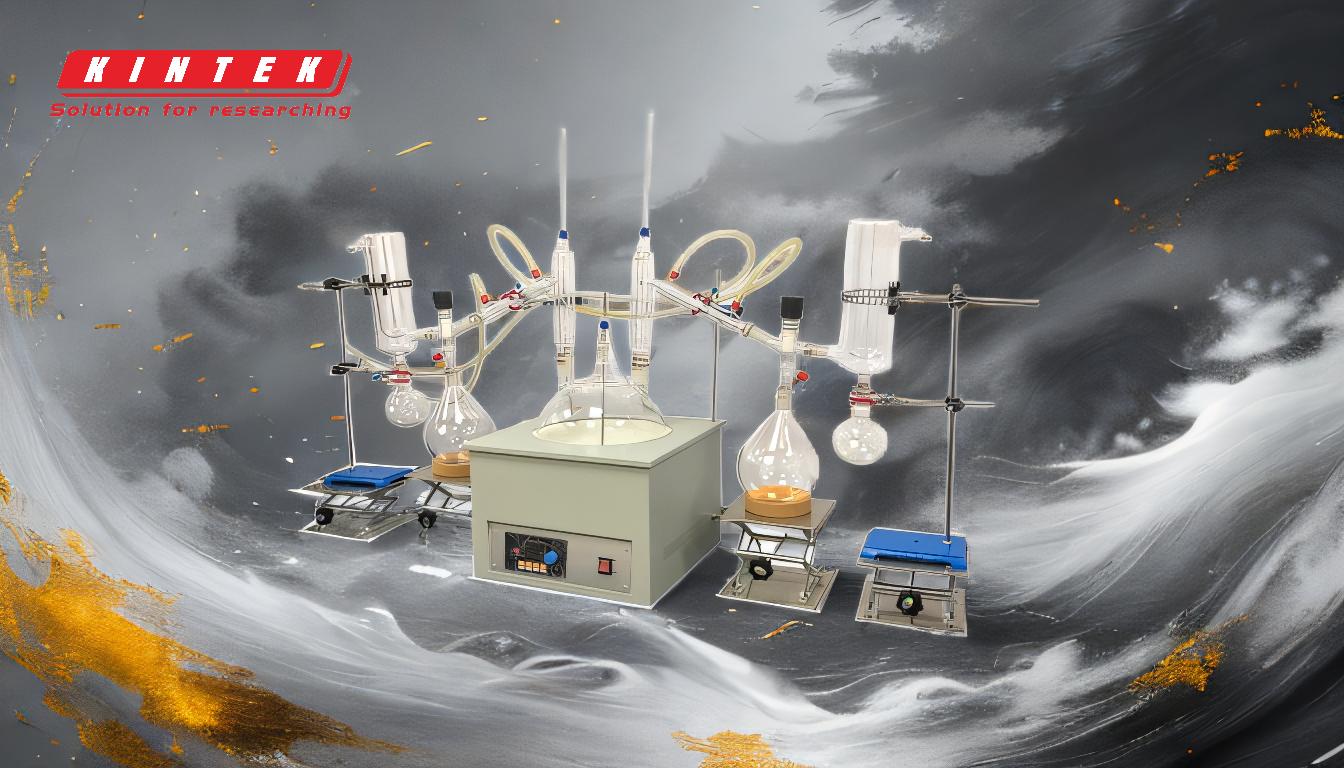Short-path distillation is a specialized distillation technique used to separate and purify compounds based on their boiling points under reduced pressure. This method is particularly effective for heat-sensitive materials, as it minimizes thermal degradation by operating at lower temperatures and reducing the distance vapors travel. The process involves heating a mixture in a flask under vacuum conditions, causing components to evaporate at lower temperatures. The vapors then travel a short distance to a condensing unit, where they are cooled and collected in separate flasks based on their molecular weight and volatility. This method is widely used in industries such as pharmaceuticals, essential oils, and cannabis extraction due to its efficiency and precision.
Key Points Explained:

-
Principle of Short-Path Distillation:
- Short-path distillation relies on the principle of separating compounds based on their boiling points under reduced pressure. By lowering the atmospheric pressure inside the distillation apparatus, the boiling points of the compounds are reduced, allowing for efficient separation at lower temperatures. This is particularly useful for heat-sensitive materials that may degrade at higher temperatures.
-
Key Components of the Apparatus:
- Feed Vessel: The starting material is placed in a feed vessel, which is then transferred to the distillation flask.
- Heated Flask: The flask is heated gradually to specific temperatures, causing the components of the mixture to evaporate.
- Vacuum System: A vacuum is applied to reduce the pressure inside the flask, lowering the boiling points of the compounds and facilitating faster evaporation.
- Fractionating Tube: Vapors travel through this tube, where they cool, condense, and re-vaporize, further separating the mixture.
- Condensing Unit: The vapors are condensed back into liquid form in this unit, which is typically cooled by a recirculating chiller.
- Receiving Flasks: The condensed fractions are collected in separate flasks based on their weight and volatility.
-
Process Steps:
- Heating and Evaporation: The mixture is heated in the flask, and the temperature is gradually increased to the boiling points of the components. The vacuum helps lower the boiling points, making the process faster and more efficient.
- Vapor Travel and Condensation: The vapors travel a short distance (hence the name "short-path") to the condensing unit, where they are cooled and condensed back into liquid form.
- Fraction Collection: The condensed liquids are collected in separate receiving flasks based on their molecular weight and volatility. This allows for the isolation of specific components from the mixture.
-
Advantages of Short-Path Distillation:
- Efficiency: The process is highly efficient due to the reduced boiling points under vacuum, allowing for faster separation.
- Precision: The short distance that vapors travel minimizes the risk of contamination and ensures precise separation of components.
- Suitability for Heat-Sensitive Materials: The lower operating temperatures make this method ideal for heat-sensitive compounds that may degrade at higher temperatures.
- Compact Design: The apparatus is relatively compact, making it suitable for laboratory settings where space is limited.
-
Applications:
- Pharmaceuticals: Used for the purification of active pharmaceutical ingredients (APIs) and other heat-sensitive compounds.
- Essential Oils: Effective for the extraction and purification of essential oils from plant materials.
- Cannabis Extraction: Widely used in the cannabis industry for the purification of cannabinoids and terpenes.
- Chemical Research: Utilized in laboratories for the separation and purification of various chemical compounds.
-
Comparison with Other Distillation Methods:
- Fractional Distillation: While both methods separate compounds based on boiling points, short-path distillation operates under vacuum, allowing for lower temperatures and reduced thermal degradation.
- Steam Distillation: Unlike steam distillation, which uses water vapor to carry compounds, short-path distillation relies on vacuum and heat to separate components.
- Molecular Distillation: Short-path distillation is a type of molecular distillation, but it specifically refers to the short distance that vapors travel, making it more compact and efficient.
In summary, short-path distillation is a highly efficient and precise method for separating and purifying compounds, particularly those that are heat-sensitive. Its ability to operate under reduced pressure and lower temperatures makes it a valuable technique in various industries, from pharmaceuticals to essential oils and cannabis extraction.
Summary Table:
| Key Aspect | Details |
|---|---|
| Principle | Separates compounds based on boiling points under reduced pressure. |
| Key Components | Feed vessel, heated flask, vacuum system, fractionating tube, condensing unit, receiving flasks. |
| Process Steps | Heating and evaporation, vapor travel and condensation, fraction collection. |
| Advantages | High efficiency, precision, suitability for heat-sensitive materials, compact design. |
| Applications | Pharmaceuticals, essential oils, cannabis extraction, chemical research. |
| Comparison | Operates under vacuum, lower temperatures, and shorter vapor travel distance compared to other methods. |
Learn how short-path distillation can optimize your processes—contact our experts today!










